Hungary in World War II
During World War II, the Kingdom of Hungary was a member of the Axis powers.[1] In the 1930s, the Kingdom of Hungary relied on increased trade with Fascist Italy and Nazi Germany to pull itself out of the Great Depression. Hungarian politics and foreign policy had become more stridently nationalistic by 1938, and Hungary adopted an irredentist policy similar to Germany's, attempting to incorporate ethnic Hungarian areas in neighboring countries into Hungary. Hungary benefited territorially from its relationship with the Axis. Settlements were negotiated regarding territorial disputes with the Czechoslovak Republic, the Slovak Republic, and the Kingdom of Romania. In 1940, Hungary joined the Axis powers. The following year, Hungarian forces participated in the invasion of Yugoslavia and the invasion of the Soviet Union. Their participation was noted by German observers for its particular cruelty, with occupied peoples subjected to arbitrary violence. Hungarian volunteers were sometimes referred to as engaging in "murder tourism."[2]
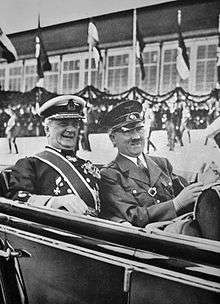
While waging war against the Soviet Union, Hungary engaged in armistice negotiations with the United States and the United Kingdom. Hitler discovered this betrayal, and in March 1944, German forces occupied Hungary. When Soviet forces began threatening Hungary, an armistice was signed between Hungary and the USSR by Regent Miklós Horthy. Soon afterward, Horthy's son was kidnapped by German commandos and Horthy was forced to revoke the armistice. The Regent was then deposed from power, while Hungarian fascist leader Ferenc Szálasi established a new government, with German backing. In 1945, Hungarian and German forces in Hungary were defeated by advancing Soviet armies.
Approximately 300,000 Hungarian soldiers and more than 600,000 civilians died during World War II, including among them more than 400,000 Jews and 28,000 Roma. Many cities were damaged, most notably the capital Budapest. Most Jews in Hungary were protected from deportation to German extermination camps for the first few years of the war, although they had for a longer period been subjected to a series of anti-Jewish laws which imposed limits on Jewish participation in Hungary's public and economic life.[3] From the start of the German occupation of Hungary in 1944, Jews and Roma were deported to the Auschwitz concentration camp. By the end of the war, the death toll was between 450,000 and 606,000 Hungarian Jews[4] and an estimated 28,000 Hungarian Roma.[5] Hungary's borders were returned to their pre-1938 lines after its surrender.
Movement to the right

In Hungary, the joint effect of the Great Depression and the Treaty of Trianon resulted in shifting the political mood of the country towards the right. In 1932, the regent Miklós Horthy appointed a new Prime Minister, Gyula Gömbös. Gömbös was identified with the Hungarian National Defence Association (Magyar Országos Véderő Egylet, or MOVE). He led Hungarian international policy towards closer cooperation with Germany, and started an effort to assimilate minorities in Hungary. Gömbös signed a trade agreement with Germany (21 February 1934)[6] that led to fast expansion of the economy, drawing Hungary out of the Great Depression but making the country dependent on the German economy for both raw materials and export revenues.
Gömbös advocated a number of social reforms, one-party government, revision of the Treaty of Trianon, and Hungary's withdrawal from the League of Nations. Although he assembled a strong political machine, his efforts to achieve his vision and reforms were frustrated by a parliament composed mostly of István Bethlen's supporters and by Hungary's creditors, who forced Gömbös to follow conventional policies in dealing with the economic and financial crisis. The result of the 1935 elections gave Gömbös more solid support in parliament. He succeeded in gaining control of the ministries of finance, industry, and defense and in replacing several key military officers with his supporters. In October 1936, he died due to kidney problems without realizing his goals.
Hungary used its relationship with Germany to attempt to revise the Treaty of Trianon. In 1938, Hungary openly repudiated the treaty's restrictions on its armed forces. Adolf Hitler gave promises to return lost territories and threats of military intervention and economic pressure to encourage the Hungarian Government to support the policies and goals of Nazi Germany. In 1935, a Hungarian fascist party, the Arrow Cross Party, led by Ferenc Szálasi was founded. Gömbös' successor, Kálmán Darányi, attempted to appease both Nazis and Hungarian antisemites by passing the First Jewish Law, which set quotas limiting Jews to 20% of positions in several professions. The law satisfied neither the Nazis nor Hungary's own radicals, and when Darányi resigned in May 1938 Béla Imrédy was appointed Prime Minister.

Imrédy's attempts to improve Hungary's diplomatic relations with the United Kingdom initially made him very unpopular with Germany and Italy. Aware of Germany's Anschluss with Austria in March, he realized that he could not afford to alienate Germany and Italy on a long-term basis: in the autumn of 1938 his foreign policy became very much pro-German and pro-Italian.[1] Intent on amassing a powerbase in Hungarian right wing politics, Imrédy started to suppress political rivals, so the increasingly influential Arrow Cross Party was harassed, and eventually banned by Imrédy's administration. As Imrédy drifted further to the right, he proposed that the government be reorganized along totalitarian lines and drafted a harsher Second Jewish Law. Imrédy's political opponents, however, forced his resignation in February 1939 by presenting documents showing that his grandfather was a Jew. Nevertheless, the new government of Count Pál Teleki approved the Second Jewish Law, which cut the quotas on Jews permitted in the professions and in business. Furthermore, the new law defined Jews by race instead of just religion, thus altering the status of those who had formerly converted from Judaism to Christianity.
Territorial expansion
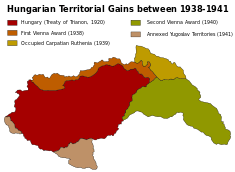
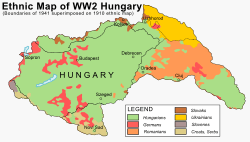
Nazi Germany and Fascist Italy sought to peacefully enforce the claims of Hungarians on territories Hungary had lost with the signing of the 1920 Treaty of Trianon. Two significant territorial awards were made. These awards were known as the First Vienna Award and the Second Vienna Award.
In October 1938, the Munich Agreement caused the dissolution of the Czechoslovak Republic and the creation of the Czech-Slovak Republic (also known as the "Second Czechoslovak Republic"). Some autonomy was granted to Slovakia and to Carpathian Ruthenia in the new republic. On 5 October, about 500 members of the Hungarian Ragged Guard infiltrated Slovakia and Ruthenia as "guerrillas". On 9 October, the Kingdom of Hungary started talks with the Czecho-Slovak Republic over Magyar-populated regions of southern Slovakia and southern Ruthenia. On 11 October, the Hungarian guards were defeated by Czecho-Slovak troops at Berehovo and Borzsava in Ruthenia. The Hungarians suffered approximately 350 casualties and, by 29 October, the talks were deadlocked.[7]
First Vienna Award
On 2 November 1938, the First Vienna Award transferred to Hungary parts of southern Slovakia and Carpathian Ruthenia from Czechoslovakia, an area amounting to 11,927 km² and a population of 869,299 (86.5% of which were Hungarians[8]). Between 5 and 10 November, Hungarian armed forces occupied the newly transferred territories.[7]
Occupation of Carpatho-Ukraine
In March 1939, the Czecho-Slovak Republic was dissolved, Germany invaded it, and the Protectorate of Bohemia and Moravia was established. On 14 March, Slovakia declared itself to be an independent state. On 15 March, Carpatho-Ukraine declared itself to be an independent state. Hungary rejected the independence of Carpatho-Ukraine and, between 14 and 18 March, Hungarian armed forces occupied the rest of Carpathian Ruthenia and ousted the government of Avgustyn Voloshyn. By contrast, Hungary recognized the German puppet state of Slovakia led by the Clerical Fascist Jozef Tiso.[9] But on 23 March 1939, Hungarian attacks Slovakia on the east claiming a border dispute, led to a localized armed conflict between the two countries. The Slovak–Hungarian War, also known as the "Little War", ended with Hungary gaining the easternmost strip of Slovakia, 1697 km².
Second Vienna Award
In September 1940, with troops massing on both sides of the Hungarian-Romanian border, war was averted by the Second Vienna Award. This award transferred to Hungary the northern half of Transylvania, with a total area of 43,492 km² and a total population of 2,578,100 divided more or less evenly between Hungarians and Romanians (depending on the census, cf. Second Vienna Award). By dividing Transylvania between Romania and Hungary, Hitler was able to ease tensions in both countries.
Occupation and annexation of Yugoslav territories
After invading Yugoslavia on 11 April 1941, Hungary annexed sections of Baranja, Bačka, Međimurje, and Prekmurje.[10] The returned territories – 11417 km² – had a population of 1,025,508 which comprised 36.6% Hungarians, 19% Germans, 16% Serbs and 28.4% others.[11]
Administration of Greater Hungary
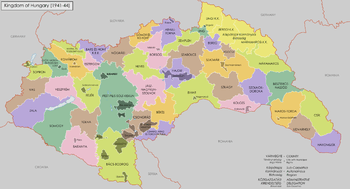
Following the two Vienna awards, a number of counties that had been lost in whole or part by the Treaty of Trianon were restored to Hungary. As a result, some previously county of temporary united administration – in Hungarian közigazgatásilag egyelőre egyesített vármegye (k.e.e. vm.) – were de-merged and restored to their pre-1920 boundaries.
The region of Sub-Carpathia was planned to be granted a special autonomous status with the intention that (eventually) it would be self-governed by the Ruthenian minority. This was prepared and billed in the Hungarian Parliament, but in the end, after the outbreak of the Second World War it never passed through.[12] However, in the corresponding territory the Governorate of Subcarpathia was formed which was divided into three, the administrative branch offices of Ung (Hungarian: Ungi közigazgatási kirendeltség), Bereg (Hungarian: Beregi közigazgatási kirendeltség) and Máramaros (Hungarian: Máramarosi közigazgatási kirendeltség), having Hungarian and Rusyn language as official languages.
Military campaigns
Invasion of Yugoslavia
On 20 November 1940, under pressure from Germany, Hungarian prime Minister Pál Teleki signed the Tripartite Pact. In December 1940, Teleki also signed an ephemeral "Treaty of Eternal Friendship" with the Kingdom of Yugoslavia. At that time, Yugoslavia was under a Regent, Prince Paul who was also under German pressure.
On 25 March 1941, Prince Paul signed the Tripartite Pact on behalf of Yugoslavia. Two days later, a Yugoslavian coup d'état removed Prince Paul, replaced him with pro-British King Peter, and threatened the success of the planned German invasion of the Soviet Union.
Hitler asked the Hungarians to support his invasion of Yugoslavia. He promised to return some territory to Hungary in exchange for military cooperation. On 3 April 1941, unable to prevent Hungary's participation in the war alongside Germany, Teleki committed suicide. The right-wing radical László Bárdossy succeeded him as Prime Minister.
Three days after Teleki's death, the Luftwaffe bombed Belgrade without warning. The German Army invaded Yugoslavia and quickly crushed Yugoslavian armed resistance. Horthy dispatched the Hungarian Third Army to occupy Vojvodina.
Invasion of the Soviet Union
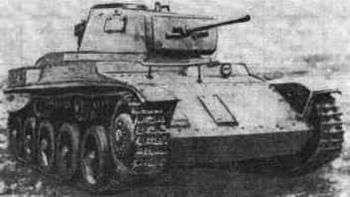
Hungary did not immediately participate in the invasion of the Soviet Union. The invasion began on 22 June 1941, but Hitler did not directly ask for Hungarian assistance. Nonetheless, many Hungarian officials argued for participation in the war in order to encourage Hitler not to favour Romania in the event of border revisions in Transylvania. On 26 June 1941, the Soviet air force bombed Košice (Kassa). Some speculation exists that this was a "false-flag" attack instigated by Germany (possibly in cooperation with Romania) to give Hungary a casus belli for joining Operation Barbarossa and the war.[13][14] Hungary declared war against the Soviets on 27 June 1941.
On 1 July 1941, under German instruction, the Hungarian "Carpathian Group" (Karpat Group) attacked the 12th Soviet Army. Attached to the German 17th Army, the Karpat Group advanced far into Soviet Ukraine, and, later, southern Russia. At the Battle of Uman, fought between 3 and 8 August, the Karpat Group's mechanized corps acted as one half of a pincer that encircled the 6th Soviet Army and the 12th Soviet Army. Twenty Soviet divisions were captured or destroyed in this action.
In July 1941, the Hungarian government transferred responsibility for 18,000 Jews from Carpato-Ruthenian Hungary to the German armed forces. These Jews, without Hungarian citizenship, were sent to a location near Kamenets-Podolski, where in one of the first acts of mass killing of Jews during World War II, all but two thousand of these individuals were shot by Nazi mobile killing units.[15][16] Bárdossy then passed the "Third Jewish Law" in August 1941, prohibiting marriage and sexual intercourse of Hungarians with Jews.
Six months after the mass murder at Kamianets-Podilskyi in January 1942, Hungarian troops massacred 3,000 Serbian and Jewish hostages near Novi Sad, Yugoslavia.
Worried about Hungary's increasing reliance on Germany, Admiral Horthy forced Bárdossy to resign and replaced him with Miklós Kállay, a veteran conservative of Bethlen's government. Kállay continued Bárdossy's policy of supporting Germany against the Red Army while also initiating negotiations with the Western Allies. Hungarian participation in Operation Barbarossa during 1941 was limited in part because the country had no real large army before 1939, and time to train and equip troops had been short. But by 1942, tens of thousands of Hungarians were fighting on the eastern front in the Royal Hungarian Army.
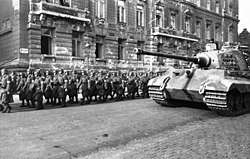
During the Battle of Stalingrad, the Hungarian Second Army suffered terrible losses. The Soviet breakthrough at the Don River sliced directly through the Hungarian units. Shortly after the fall of Stalingrad in January 1943, the Hungarian 2nd Army was crushed by the Soviets at the Battle of Voronezh. Ignoring German orders to stand and fight to the death, the bewildered Hungarian troops, fighting without antitank weaponry or armored support, turned and fled. Harassed by partisan groups and Soviet air attacks, and having to endure the Russian winter weather, they tried in vain to retreat. Most of the survivors were taken prisoner by the Soviet army, and total casualties numbered more than 100,000 men. The Hungarian army ceased to exist as an effective fighting force, and the Germans pulled them from the front.
While Kállay was Prime Minister, the Jews endured increased economic and political repression, although many, particularly those in Budapest, were temporarily protected from the final solution. For most of the war, the Hungarian Jews lived an uneasy existence. They were deprived of most freedoms, but were not subjected to physical harm, and Horthy tried to contain anti-Semitic groups like the Arrow Cross. Secret negotiations with the British and Americans continued. As per the request of the Western Allies, there were no connections made with the Soviets.
German occupation of Hungary
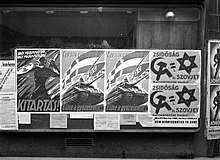
Aware of Kállay's deceit and fearing that Hungary might conclude a separate peace, in March 1944, Hitler launched Operation Margarethe and ordered Nazi troops to occupy Hungary. Horthy was confined to a castle, in essence, placed under house arrest. Döme Sztójay, an avid supporter of the National Socialists, became the new Prime Minister. Sztójay governed with the aid of a National Socialist military governor, Edmund Veesenmayer. The Hungarian populace was not happy with their nation being reduced in effect to a German protectorate, but Berlin threatened to occupy Hungary with Slovak, Croat, and Romanian troops if they did not comply. The thought of these ancestral enemies on Hungarian soil was seen as far worse than German control. Ironically, Hungary still kept whole divisions on the border with Romania even as the troops of both nations were fighting and dying together in the Russian winter.
As the Soviets pushed westward, Sztojay's government proceeded to muster new armies. The Hungarian troops again suffered terrible losses, but now had a motive to protect their homeland from Soviet occupation.
In August 1944, Horthy replaced Sztójay with the anti-Fascist General Géza Lakatos. Under the Lakatos regime, acting Interior Minister Béla Horváth ordered Hungarian gendarmes to prevent any Hungarian citizens from being deported. The Germans were unhappy with the situation, but could not do a great deal about it. Horthy's actions thus bought the Jews of Budapest a few months of time.
Soviet occupation of Hungary

In September 1944, Soviet forces crossed the Hungarian border. On 15 October, Horthy announced that Hungary had signed an armistice with the Soviet Union. The Hungarian army ignored the armistice, fighting desperately to keep the Soviets out. The Germans launched Operation Panzerfaust and, by kidnapping his son Miklós Horthy Jr., forced Horthy to abrogate the armistice, depose the Lakatos government, and name the leader of the Arrow Cross Party, Ferenc Szálasi, as Prime Minister. Horthy resigned and Szálasi became Prime Minister of a new "Government of National Unity" (Nemzeti Összefogás Kormánya) controlled by the Germans. Horthy himself was taken to Germany as a prisoner. He ultimately survived the war and spent his last years exiled in Portugal, dying in 1957.
In cooperation with the Nazis, Szálasi attempted to resume deportations of Jews, but Germany's fast-disintegrating communications largely prevented this from happening. Nonetheless, the Arrow Cross launched a reign of terror against the Jews of Budapest. Thousands were tortured, raped and murdered in the last months of the war, and their property looted or destroyed. Swedish diplomat Raoul Wallenberg saved thousands of Budapest Jews using Swedish protective passports. He was ultimately taken prisoner by the Soviets and died some years later in a labor camp. Other foreign diplomats like Nuncio Angelo Rotta, Giorgio Perlasca, Carl Lutz, Friedrich Born, Harald Feller, Angel Sanz Briz and George Mandel-Mantello also organized false papers and safe houses for Jews in Budapest. Of the approximately 800,000 Jews residing within Hungary's expanded borders of 1941, only 200,000 (about 25%) survived the Holocaust.[17] An estimated 28,000 Hungarian Roma were also killed as part of the Porajmos.
Soon Hungary itself became a battlefield. Szálasi promised a Greater Hungary and prosperity for the peasants, but in reality Hungary was crumbling and its armies were slowly being destroyed. As an integral part of German General Maximilian Fretter-Pico's Armeegruppe Fretter-Pico, the re-formed Hungarian Second Army enjoyed a modest level of combat success. From 6 to 29 October 1944, during the Battle of Debrecen, Armeegruppe Fretter-Pico managed to achieve a major win on the battlefield. Avoiding encirclement itself, Armeegruppe Fretter-Pico encircled and severely mauled three Soviet tank corps serving under the Mobile Group of Issa Pliyev. Earlier in the same battle, Mobile Group Pliyev had sliced through the Hungarian Third Army. But success was costly and, unable to replace lost armor and heavy artillery munitions, the Hungarian Second Army was defeated on 1 December 1944. The remnants of the Second Army were incorporated into the Third Army.
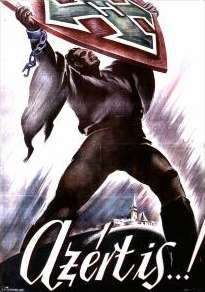
In October 1944, the Hungarian First Army was attached to the German 1st Panzer Army, participating defensively against the Red Army's advance towards Budapest. On 28 December 1944, a provisional government was formed in Hungary under acting Prime Minister Béla Miklós. Miklós and Szálasi each claimed to be the legitimate Head of government. The Germans and pro-German Hungarians loyal to Szálasi fought on.
The Soviets and Romanians completed the encirclement of Budapest on 29 December 1944. The battle for the city turned into the Siege of Budapest. During the fight, most of what remained of the Hungarian First Army was destroyed about 200 kilometres (120 mi) north of Budapest in a running battle from 1 January to 16 February 1945. On 20 January 1945, representatives of the Miklós provisional government signed an armistice in Moscow. In January 1945, 32,000 ethnic Germans from within Hungary were arrested and transported to the Soviet Union as forced laborers. In some villages, the entire adult population were taken to labor camps in the Donets Basin.[18][19]:21 Many died there as a result of hardships and ill-treatment. Overall, between 100,000 and 170,000 Hungarian ethnic Germans were transported to the Soviet Union.[20]:38
The remaining German and Hungarian units within Budapest surrendered on 13 February 1945. Although the German forces in Hungary were generally defeated, the Germans had one more surprise for the Soviets. On 6 March 1945, the Germans launched the Lake Balaton Offensive, attempting to hold on to the Axis' last source of oil. It was their final operation of the war and it quickly failed. By 19 March 1945, Soviet troops had recaptured all the territory lost during the 13-day German offensive.[21]:182
After the failed offensive, the Germans in Hungary were eliminated. Most of what remained of the Hungarian Third Army was destroyed about 50 kilometres (31 mi) west of Budapest between 16 and 25 March 1945. From 26 March and 15 April, the Soviets and Bulgarians launched the Nagykanizsa–Körmend Offensive and more Hungarian remnants were destroyed as part of Army Group South fighting alongside the 2nd Panzer Army. By the start of April, the Germans, with the Arrow Cross in tow, had completely vacated Hungarian soil.
Retreat into Germany
Officially, Soviet operations in Hungary ended on 4 April 1945, when the last German troops were expelled. Some pro-Fascist Hungarians like Szálasi escaped—for a time—with the Germans. A few pro-German Hungarian units fought on until the end of the war. Units like the Szent László Infantry Division ended the war in southern Austria.
On 8 May 1945, at 4:10 p.m. Major General Stanley Eric Reinhart's 259th Infantry Regiment was authorized to accept the surrender of the 1st Hungarian Cavalry Division and of the 1st Hungarian Panzer Division. Surrender and movement across the Enns River had to be completed prior to midnight.
In the town of Landsberg in Bavaria, a Hungarian garrison stood in parade formation to surrender as the Americans advanced through the area very late in the war.[22] A few Hungarian soldiers ended the war in Denmark in some of the last Nazi territory not yet occupied.
List of major engagements
This is a list of battles and other combat operations in World War II in which Hungarian forces took part.
Oppression at home
The Holocaust
On 19 March 1944 German troops occupied Hungary, prime minister Miklós Kállay was deposed and soon mass deportations of Jews to German death camps in occupied Poland began. SS-Obersturmbannführer Adolf Eichmann went to Hungary to oversee the large-scale deportations. Between 15 May and 9 July, Hungarian authorities deported 437,402 Jews. All but 15,000 of these Jews were sent to Auschwitz-Birkenau,[15] and 90% of those were immediately killed. It has been estimated that one-third of the murdered victims at Auschwitz were Hungarian.[23] Sztojay, unlike previous prime ministers, answered mostly to Berlin and was thus able to act independently of Horthy. However, reports of the conditions in the concentration camps led the admiral to resist his policies.
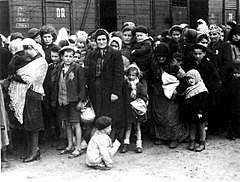
In early July 1944, Horthy stopped the deportations, and after the failed attempt on Hitler's life, the Germans backed off from pressing Horthy's regime to continue further, large-scale deportations, although some smaller groups continued to be deported by train. In late August, Horthy refused Eichmann's request to restart the deportations. Himmler ordered Eichmann to leave Budapest.[24]
Forced labor
The forced labor service system was introduced in Hungary in 1939. The system affected primarily the Jewish population, but many people belonging to minorities, sectarians, leftists and Roma were also inducted.
Thirty-five thousand to 40,000 forced laborers, mostly Jews or of Jewish origin, served in the Hungarian Second Army, which fought in the USSR (see below). Eighty percent of them—28,000 to 32,000 people—never returned; they died either on the battlefield or in captivity.
Approximately half of the 6,000 Jewish forced laborers working in the copper mines in Bor, Yugoslavia (now Serbia) were executed by the Germans during the death march from Bor to Győr in August–October 1944, including the 35-year-old poet Miklós Radnóti, shot at the Hungarian village of Abda for being too weak to continue after a savage beating.[25][26]
Resistance movement
In autumn of 1941 anti-German demonstrations took place in Hungary. On 15 March 1942, the anniversary of the outbreak of the 1848–49 War of Independence, a crowd of 8,000 people gathered at the Sándor Petőfi monument in Budapest to demand an "independent democratic Hungary". The underground Hungarian Communist Party published newspaper and leaflets, 500 communist activists were arrested and the party's leaders Ferenc Rózsa and Zoltán Schönherz were executed.
The Hungarian underground opposition contributed little to the military defeat of National Socialism. In July 1943 the Smallholders Party adopted Endre Bajcsy-Zsilinszky's policy of working more closely with Hungarian Social Democratic Party and the Communists and on 31 July demanded from the government an end to hostilities and joining the Allies even at the price of armed conflict with Germany. At the beginning of August 1943 a programme of action was formally concluded with the Social Democrats and on 11 September they issued a joint declaration against the war on the side of Germany.
Various opposition groups deprived of their leaders most of whom had been arrested by the Gestapo after the German occupation in March 1944 joined forces in May 1944 in the Communist-inspired Hungarian Front (Magyar Front). They demanded a "new struggle of liberation" against the German occupation forces and their collaborators and called for the creation of a new democratic Hungary after the war. The representatives of the Hungarian Front, being informed by Horthy of plans for an armistice on 11 October, founded the Committee of Liberation of the Hungarian National Uprising on 11 November 1944. Although immediately weakened by the arrest and execution of its leaders, it called for an armed uprising against the German forces which took the form of limited isolated partisan actions and attacks on German military installations.[27]
Peace treaty
By 2 May 1945, Hitler was dead and Berlin surrendered. On 7 May, General Alfred Jodl, the German Chief of Staff, signed the surrender of Germany. On 23 May, the "Flensburg Government" was dissolved. On 11 June, the Allies agreed to make 8 May 1945 the official "Victory in Europe" day.[21]:298
The Treaty of Peace with Hungary[28] signed on 10 February 1947 declared that "The decisions of the Vienna Award of 2 November 1938 are declared null and void" and Hungarian boundaries were fixed along the former frontiers as they existed on 1 January 1938, except a minor loss of territory on the Czechoslovakian border. Two-thirds of the ethnic German minority (202,000 people) was deported to Germany in 1946–48, and there was a forced "population exchange" between Hungary and Czechoslovakia.
On 1 February 1946, the Kingdom of Hungary was formally abolished and replaced by the Second Republic of Hungary. Post-war Hungary was eventually taken over by a Soviet-allied government and became part of the Eastern Bloc. The People's Republic of Hungary was declared in 1949 and lasted until the Revolutions of 1989 and the End of Communism in Hungary.
Notes
- Hungary: The Unwilling Satellite Archived 16 February 2007 at the Wayback Machine John F. Montgomery, Hungary: The Unwilling Satellite. Devin-Adair Company, New York, 1947. Reprint: Simon Publications, 2002.
- Ungváry, Krisztián (23 March 2007). "Hungarian Occupation Forces in the Ukraine 1941–1942: The Historiographical Context". The Journal of Slavic Military Studies. 20 (1): 81–120. doi:10.1080/13518040701205480. ISSN 1351-8046.
- Pogany, Istvan, Righting Wrongs in Eastern Europe, Manchester University Press, 1997, pp.26–39, 80–94.
- Dawidowicz, Lucy. The War Against the Jews, Bantam, 1986, p. 403; Randolph Braham, A Magyarországi Holokauszt Földrajzi Enciklopediája (The Geographic Encyclopedia of the Holocaust in Hungary), Park Publishing, 2006, Vol 1, p. 91.
- Crowe, David. "The Roma Holocaust," in Barnard Schwartz and Frederick DeCoste, eds., The Holocaust's Ghost: Writings on Art, Politics, Law and Education, University of Alberta Press, 2000, pp. 178–210.
- '2. Zusatzvertrag zum deutsch-ungarischen Wirtschaftsabkommen von 1931 (Details Archived 4 November 2016 at the Wayback Machine)
- Thomas, The Royal Hungarian Army in World War II, pg. 11
- "AZ ELSŐ BÉCSI DÖNTÉS SZÖVEGE". www.arcanum.hu (in Hungarian). Arcanum Adatbázis Kft.
- "Slovakia". U.S. Department of State.
- Hungary Archived 3 February 2007 at the Wayback Machine – Shoah Foundation Institute Visual History Archive
- "Délvidék visszacsatolása". www.arcanum.hu (in Hungarian). Arcanum Adatbázis Kft.
- Géza Vasas – A ruszin autonómia válaszútjain (1939. március-szeptember) – On the crossroads of Ruthenian autonomy (March–September 1939),
- Dreisziger, N.F. (1972). "New Twist to an Old Riddle: The Bombing of Kassa (Košice), June 26, 1941". The Journal of Modern History. The University of Chicago Press. 44 (2): 232–242. doi:10.1086/240751.
- "Бомбежка Кошице" (in Russian). Archived from the original on 15 October 2011.
- Holocaust in Hungary Archived 9 June 2011 at the Wayback Machine Holocaust Memorial Centre.
- "Hungary Before the German Occupation". Archived from the original on 2 March 2012. Retrieved 22 September 2009.
- Victims of Holocaust Archived 11 March 2008 at the Wayback Machine – Holocaust Memorial Centre.
- Wasserstein, Bernard (17 February 2011). "European Refugee Movements After World War Two". BBChistory. Archived from the original on 19 July 2013. Retrieved 5 August 2013.
- Ther, Philipp (1998). Deutsche Und Polnische Vertriebene: Gesellschaft und Vertriebenenpolitik in SBZ/ddr und in Polen 1945–1956. ISBN 3-525-35790-7.
- Prauser, Steffen; Rees, Arfon (December 2004). "The Expulsion of 'German' Communities from Eastern Europe at the end of the Second World War" (PDF). EUI Working Paper HEC No. 2004/1. San Domenico, Florence: European University Institute. Archived from the original (PDF) on 1 October 2009. Retrieved 5 August 2013.
- The Decline and Fall of Nazi Germany and Imperial Japan, Hans Dollinger, Library of Congress Catalogue Card Number 67-27047
- Stafford, Endgame, 1945, p. 242.
- Gábor Kádár – Zoltán Vági: Magyarok Auschwitzban. (Hungarians in Auschwitz) In Holocaust Füzetek 12. Budapest, 1999, Magyar Auschwitz Alapítvány-Holocaust Dokumentációs Központ, pp. 92–123.
- Robert J. Hanyok (2004). "Eavesdropping on Hell: Historical Guide to Western Communications Intelligence and the Holocaust, 1939–1945" (PDF). NATIONAL SECURITY AGENCY, UNITED STATES CRYPTOLOGIC HISTORY. Archived (PDF) from the original on 4 March 2016.
In late July there was a lull in the deportations. After the failed attempt on Hitler's life, the Germans backed off from pressing Horthy's regime to continue further, large-scale deportations. Smaller groups continued to be deported by train. At least one German police message decoded by GC&CS revealed that one trainload of 1,296 Jews from the town of Sarvar in western Hungary Hungarian Jews being rounded up in Budapest (Courtesy: USHMM) had departed for Auschwitz on August 4.112 In late August Horthy refused Eichmann's request to restart the deportations. Himmler ordered Eichmann to leave Budapest
- Gilbert, Martin (1988). Atlas of the Holocaust. Toronto: Lester Publishing Limited. pp. 10, 206. ISBN 1-895555-37-X.
- Perez, Hugo (2008). "Neither Memory Nor Magic: The Life and Times of Miklos Radnoti". M30A Films. Archived from the original on 9 October 2013. Retrieved 5 August 2013.
- "THE HISTORY OF HUNGARY". Archived from the original on 6 May 2016.
- Treaty of Peace with Hungary Archived 4 December 2004 at the Wayback Machine
References
- Dollinger, Hans. The Decline and Fall of Nazi Germany and Imperial Japan. Library of Congress Catalogue Card Number 67-27047
- Braham, Randolph (1981). The Politics of Genocide: The Holocaust in Hungary. Columbia University Press.
- Fenyö, Mario D. (1969). "Some Aspects of Hungary's Participation in World War II". East European Quarterly. 3 (2): 219–29.
- Herczl, Moshe Y. Christianity and the Holocaust of Hungarian Jewry (1993)online
- Stafford, David. Endgame, 1945: The Missing Final Chapter of World War II. Little, Brown and Company, New York, 2007. ISBN 978-0-31610-980-2
- Szabo, Laszlo Pal; Thomas, Nigel (2008). The Royal Hungarian Army in World war II. New York: Osprey Publishing. p. 48. ISBN 978-1-84603-324-7.
